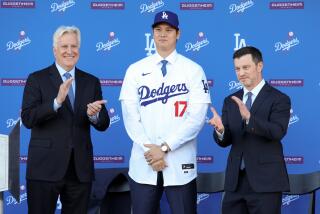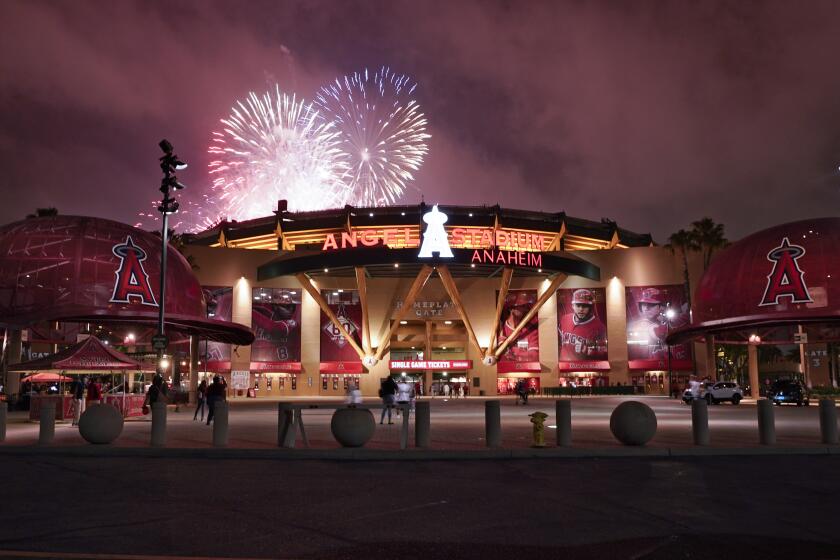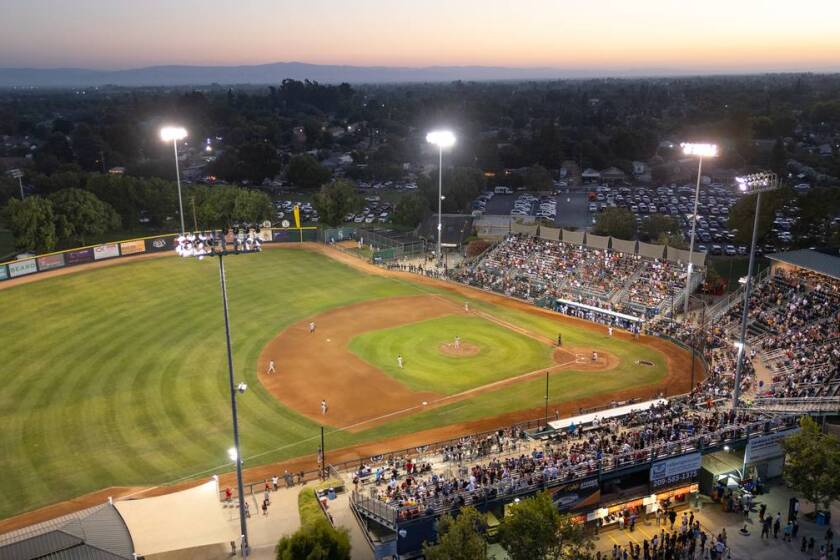
- Share via
PHOENIX — The last time Major League Baseball and the players association negotiated a collective bargaining agreement, the owners locked out the players before the 2022 season, a work stoppage that nearly resulted in the loss of regular-season games for the first time since 1995.
Now, with that CBA set to expire after the 2026 season, there are growing concerns that another, potentially more destructive labor dispute could be on the horizon.
And though there will be many issues to tackle when negotiations start next year, the Dodgers’ staggering spending spree over the last two offseasons could represent some of the most contentious potential sticking points.
Payroll disparities. Competitive imbalance. And, most of all, a long-simmering fight over the potential of a hard salary cap.
Whereas last year was a crash course for Mookie Betts, the 32-year-old benefitted from a more curated plan this winter as he went through his paces at shortstop.
For decades, some owners have sought to institute a salary cap in MLB, the only of the four major North American leagues without one. The closest the league has come is its luxury tax structure, which taxes teams for surpassing certain payroll thresholds each season.
Introduced in the 2003 season, the luxury tax served as a de facto soft cap. Few teams dared surpass the threshold on a regular basis. The strengthening of tax penalties in the 2022 CBA — particularly for teams willing to blow well past thresholds — was designed to discourage any club from dominating the sport financially.
The Dodgers and their deep-pocketed Guggenheim ownership group, however, had other ideas.
After following up their $1.4-billion splurge in the previous offseason with another half-billion or so of guaranteed money this winter, the Dodgers’ hefty spending has them poised to have an MLB-record luxury tax payroll of $402 million, according to Cot’s Baseball Contracts.
That is roughly $75 million more than the next-highest payroll. It is well beyond even the most punitive tax thresholds, which start at $241 million. And it’s almost five times greater than teams at the other end of the spectrum, with the league-low $86 million payrolls of the Chicago White Sox and Miami Marlins likely to cost less than the Dodgers’ tax bill alone (projected to be about $152 million).
Against that backdrop, one question has dominated the sport this winter: Is the Dodgers’ spending bad for baseball?
On that point, at least, commissioner Rob Manfred and MLB Players’ Assn. executive director Tony Clark agree.
“The Dodgers have gone out and done everything possible, always within the rules that currently exist, to put the best possible team on the field,” Manfred said at Cactus League media day on Tuesday. “I think that’s a great thing for the game. That type of competitive spirit is what people want to see.”
In this year’s Dodger camp, the team’s loaded pitching staff has turned live batting practice sessions into star-studded affairs.
Clark echoed those sentiments Wednesday, speaking to The Times shortly after his annual meeting with Dodgers players at Camelback Ranch.
“The bigger question is, teams that have resources — and they do, whether you’re a small market, a mid-market or a large market — is why they don’t seem to be as interested in signing players that can help them be the last team standing,” he said.
Manfred didn’t fault the Dodgers’ spending the last two offseasons — when they added Shohei Ohtani, Yoshinobu Yamamoto, Tyler Glasnow and Blake Snell on nine-figure contracts — but he did talk at length about the concerns he says he’s heard from fans and owners about the payroll disparities that have emerged as a result.
“It’s clear we have fans in some markets that are concerned about the ability of the team in their market to compete with the financial resources of the Dodgers,” Manfred said at a press conference at the Arizona Biltmore Resort. “I think that disparity, as it should be, is certainly at the top of my list of concerns about what’s going on in the sport. When I say I can’t be critical of the Dodgers, they are doing what the system wants. If I’m going to be critical of something, it’s not going to be the Dodgers. It’s going to be the system.”
Manfred didn’t say whether owners would push for a salary cap, noting it’s too early to begin staking public positions. But many around the industry expect that issue to resurface next year. And if it does, an already complicated negotiation could become even more fraught.
“It’s not new,” Clark said of the potential fight over a salary cap, something the union is staunchly against. “The league has been professing doom and gloom for decades.”
Clark looks at the Dodgers as an example more teams should follow, especially after an offseason in which the majority of clubs decreased their luxury tax payrolls, despite the league netting a record $12.1 billion in revenue last season.
“We’ve always had a team, or teams, that have found themselves in the same conversation that Dodgers find themselves in here,” Clark said. “But in an industry that’s growing — and the reports about how much it’s growing are tangible and coming from the league office — why do we have so many teams that aren’t as interested in trying to improve their club as some others? That, to me, is the bigger question.”
The legitimacy of worries over competitive imbalance remains to be seen. As Clark noted, this isn’t the first time the league has had vast payroll disparities. The New York Yankees have long been heavy spenders under the ownership of the Steinbrenner family. More recently, the New York Mets had a $376.4-million luxury tax payroll in 2023, when no other team surpassed $300 million. Two years before that, the Dodgers’ $285.6-million luxury tax payroll topped all teams by $70 million.
Despite that, MLB has not had a repeat champion since the luxury tax was created in 2003. During that time, only three teams with the league’s highest payroll have won the World Series. And even for all the anticipation around the Dodgers, betting lines and computer models give them no better than roughly 3-to-1 odds of defending their title.
Past competitive balance concerns were assuaged in other ways too, from increases to the league’s revenue-sharing model (in which big-market teams share with smaller clubs) to the expansion of the postseason (which has grown from eight to 10 to 12 teams over the last couple of decades).
Over the first week of camp at Camelback Ranch, Blake Snell and Bobby Miller have walked to and from bullpen sessions together, in constant conversation with almost every step.
“There are opportunities to affect change in the system that aren’t cap-driven,” Clark said. “Let’s have a conversation about that, as opposed to what it appears to be, which is a very purposeful and deliberate focus on the one thing the league has been committed to for decades.”
For now, the baseball world can only wait and wonder, hoping the Dodgers’ disproportionate spending won’t contribute to another elongated work stoppage.
“That’d be very disappointing for all of us,” Dodgers manager Dave Roberts said. “I just hope that we all realize that it’s a pretty good game right now. Attendance has shown that. The players are better than they’ve ever been, in my opinion. So I hope and pray that we don’t lose that momentum.”
More to Read
Are you a true-blue fan?
Get our Dodgers Dugout newsletter for insights, news and much more.
You may occasionally receive promotional content from the Los Angeles Times.












